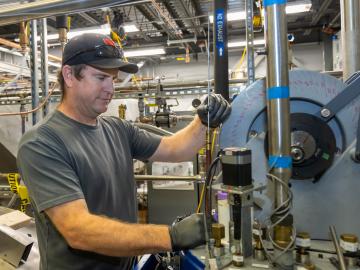Filter News
Area of Research
- Advanced Manufacturing (1)
- Biology and Environment (8)
- Clean Energy (14)
- Computer Science (2)
- Fusion and Fission (3)
- Isotope Development and Production (1)
- Isotopes (14)
- Materials (46)
- Materials for Computing (7)
- National Security (14)
- Neutron Science (14)
- Nuclear Science and Technology (5)
- Quantum information Science (1)
- Supercomputing (30)
News Type
News Topics
- (-) Cybersecurity (23)
- (-) Frontier (16)
- (-) Isotopes (25)
- (-) Net Zero (5)
- (-) Physics (41)
- (-) Polymers (17)
- (-) Quantum Science (28)
- (-) Space Exploration (3)
- 3-D Printing/Advanced Manufacturing (55)
- Advanced Reactors (12)
- Artificial Intelligence (31)
- Big Data (13)
- Bioenergy (40)
- Biology (42)
- Biomedical (25)
- Biotechnology (10)
- Buildings (21)
- Chemical Sciences (37)
- Clean Water (7)
- Climate Change (36)
- Composites (11)
- Computer Science (69)
- Coronavirus (23)
- Critical Materials (12)
- Decarbonization (31)
- Education (3)
- Element Discovery (1)
- Energy Storage (55)
- Environment (72)
- Exascale Computing (11)
- Fossil Energy (1)
- Fusion (21)
- Grid (22)
- High-Performance Computing (34)
- Hydropower (2)
- ITER (3)
- Machine Learning (17)
- Materials (65)
- Materials Science (62)
- Mathematics (3)
- Mercury (6)
- Microscopy (25)
- Molten Salt (2)
- Nanotechnology (32)
- National Security (32)
- Neutron Science (57)
- Nuclear Energy (39)
- Partnerships (26)
- Quantum Computing (10)
- Renewable Energy (1)
- Security (17)
- Simulation (12)
- Statistics (2)
- Summit (22)
- Sustainable Energy (44)
- Transformational Challenge Reactor (4)
- Transportation (36)
Media Contacts

Associate Technician Sean Hollander is the keeper of the Fundamental Neutron Physics Beamline, which is operated by the Physics Division at the Spallation Neutron Source at ORNL, where scientists use neutrons to study all manner of matter.

Scientists have uncovered the properties of a rare earth element that was first discovered 80 years ago at the very same laboratory, opening a new pathway for the exploration of elements critical in modern technology, from medicine to space travel.
The United States could triple its current bioeconomy by producing more than 1 billion tons per year of plant-based biomass for renewable fuels, while meeting projected demands for food, feed, fiber, conventional forest products and exports, according to the DOE’s latest Billion-Ton Report led by ORNL.

Two different teams that included Oak Ridge National Laboratory employees were honored Feb. 20 with Secretary’s Honor Achievement Awards from the Department of Energy. This is DOE's highest form of employee recognition.

Chelsea Chen, a polymer physicist at ORNL, is studying ion transport in solid electrolytes that could help electric vehicle battery charges last longer.

Corning uses neutron scattering to study the stability of different types of glass. Recently, researchers for the company have found that understanding the stability of the rings of atoms in glass materials can help predict the performance of glass products.



Effective Dec. 4, Gina Tourassi will assume responsibilities as associate laboratory director for the Computing and Computational Sciences Directorate at the Department of Energy’s Oak Ridge National Laboratory.

A team of researchers associated with the Quantum Science Center headquartered at the Department of Energy's Oak Ridge National Laboratory has confirmed the presence of quantum spin liquid behavior in a new material with a triangular lattice, KYbSe2.




